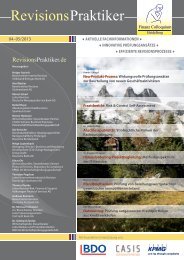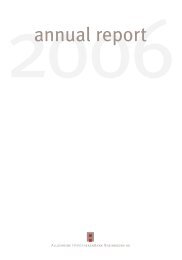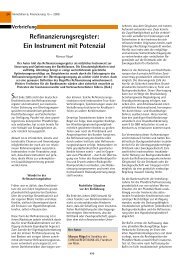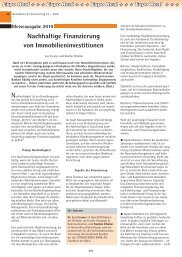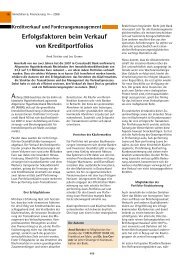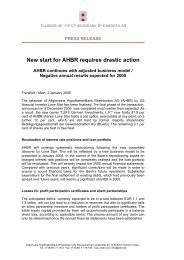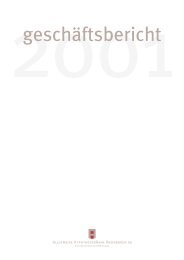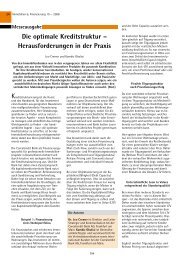COREALCREDIT BANK AG
COREALCREDIT BANK AG
COREALCREDIT BANK AG
Create successful ePaper yourself
Turn your PDF publications into a flip-book with our unique Google optimized e-Paper software.
usiness. The increase on the previous year was largely attributable to the fact that the SoFFin<br />
guarantee costs no longer applied.<br />
Administrative costs rose slightly to EUR 52.5 million (2010: EUR 49.8 million). Personnel costs<br />
declined to EUR 18.3 million (2010: EUR 20.3 million) due to a reduced headcount. Due to the<br />
costs associated with the sale of portfolios of non-performing loans and higher litigation costs,<br />
operating costs rose to EUR 34.3 million (2010: EUR 29.4 million).<br />
Net risk provisioning amounted to EUR -1.3 million in 2011 (2010: EUR -13.5 million). The net loss<br />
from securities, mainly resulting from the write-down of a Greek bond recognised in current assets<br />
in the amount of EUR 23.0 million, was largely offset by the positive credit risk provisions and a<br />
partial release of the contingency reserves established in 2008 under section 340f HGB. The risk<br />
provision of EUR 20.0 million for the indirect exposure to Greek risk arising from a credit-linked<br />
note and disposal losses on securities allocated to fixed assets affected the net result from<br />
financial investments, which amounted to EUR -36.6 million (2010: EUR 2.7 million).<br />
The adjustments to pension provisions required as a result of the implementation of the German<br />
Accounting Law Modernisation Act (BilMoG) were already recognised in the net extraordinary<br />
result in the previous year. The Bank did not exercise the option of spreading this amount over a<br />
maximum of 15 years. Thus, no additional allocation was required in the year 2011.<br />
The tax result amounted to EUR -0.3 million (2010: EUR 1.6 million). Both years included special<br />
effects from previous assessment periods. The same is true of the balance of other operating<br />
income and expenses, which amounted to EUR 0.9 million (2010: EUR 1.2 million).<br />
The net profit for the year 2011, combined with the loss brought forward from 2010, along with the<br />
replenishment of some profit participation rights, resulted in a balance sheet loss of EUR 769.5<br />
million.<br />
Summary<br />
On the whole, despite the continuing crisis in the financial markets, the Bank succeeded in further<br />
consolidating its net assets, financial and profit situation.<br />
Outlook<br />
The German real estate market proved relatively robust during the financial market crisis. External<br />
shocks from the debt crisis could still threaten the German economy, which is again growing<br />
modestly following a period of strong recovery. Demand for real estate is likely to remain steady<br />
overall. Nevertheless, there are differences between the individual quality categories; whereas<br />
excess demand for modern city centre retail and residential space is likely to continue, economic<br />
growth will probably be insufficient to make older office properties in peripheral locations attractive<br />
again.<br />
A similar trend can be seen in the investment market: as a result of the sovereign debt crisis, the<br />
flight to real assets is set to continue for the time being, keeping yields on properties with stable<br />
cash flows at a low level. At the same time, a large number of commercial mortgage backed<br />
securities (CMBSs) are due to mature in 2012 and 2013. These were used in the middle of the last<br />
decade to finance opportunistic real estate investments which have failed to achieve the<br />
performance expected. Forced sales as a result of this cannot be ruled out, particularly as the<br />
pressure on banks’ balance sheets is likely to increase somewhat overall. If this reaches a certain<br />
level, it could also have a negative impact on general property price levels. To this extent, the<br />
availability of funding is a significant risk factor for the German real estate market.<br />
This market environment opens up lending business opportunities for well positioned banks like<br />
<strong>COREALCREDIT</strong>, particularly where there is a (re)structuring requirement and a specialist bank<br />
53



